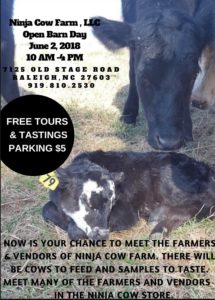
Time: 10 am – 4 pm
Vendor List:
Buck Naked Farm – Lathe Demonstration
*Parking $5, No Dogs Allowed,No Smoking, we encourage carpooling & to come later in the day*
7125 Old Stage Road Raleigh NC 919-322-0197

Time: 10 am – 4 pm
Vendor List:
Buck Naked Farm – Lathe Demonstration
*Parking $5, No Dogs Allowed,No Smoking, we encourage carpooling & to come later in the day*
Great news after much demand we are now carrying two new items in our store.
Beef Tallow
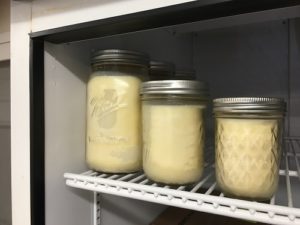
1/2 Pint- $7
Pint – $10
Quart- $15
Lard
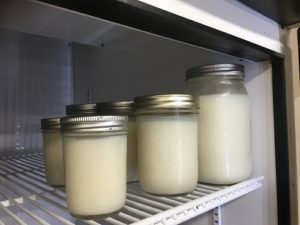
1/2 Pint- $7
Pint – $10
Quart- $15
Our New Store Hours are Monday, Wednesday, Friday 2-6 pm & Saturday from 9-5. On Saturdays we offer free group walking tours. Please go visit https://ninjacowfarm.com/tours-2/ to schedule your tour today.
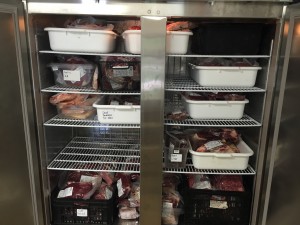
I couldn’t say anything, because I wasn’t sure if the processor would have our cows ready on time. But I got the call (after multiple attempts to get an answer this week) that our cows are ready as of this morning.
I’m on the way now to go pick up two cows worth of beef and to stuff our freezer to the gills. I will be back, and unloaded, before Lucy opens today at 2pm. That means ribeyes, NY strips, eye round roasts, etc. All the goodies will be in stock this afternoon and tomorrow.
We are open 2-6 today, and 8-5 tomorrow. No appointment needed! Stop by and get some fresh beef!
Of course, we are fully stocked on pork, chicken, dairy, etc. as well so we have all the goodies for you.
Flavors from Asia, they’re complex by nature. You bite in and instantly go “How did they do this”? Umami is a word in Asian Cuisine used to describe the savory taste. Short ribs have a bounty of Umami.
The ribs come in packs ranging from 1 lb- 2 lbs at $8.99 a lbs. With ribs you want 1 lbs per person due to the removal of bone. While this recipe is for 5 lbs I typically use 2-3 lbs of the ribs. When doing this freeze part of your unused marinade for later use.
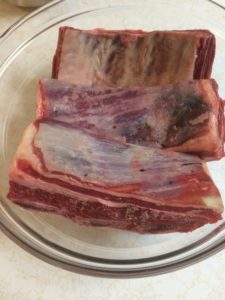
The secret to short ribs is the cooking time. Once again we are going to using that trusty dutch oven and set the oven at 280F. The length of time will vary on the density of meat, towards the end check every 30 minutes. You’re not just checking for fall off the bone you also want the connective tissue broken down enough to bite through easily.
Short Ribs with Asian Flavor
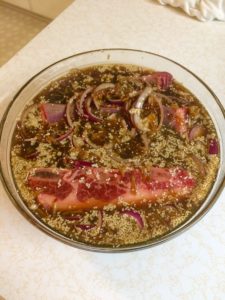
Cooking Method
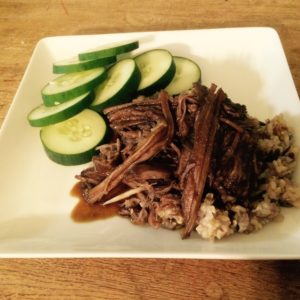
The NCF Store recently started carrying a smaller sized brisket. Instead of 7-8lbs the new cut is more manageable for a family at 2 ½ to 4 lbs. This meal fed 2 families, 5 children and 5 adults for under $70. That’s a big crowd when you realize the kids are hitting peak growth and hunger ages. Yesterday, was a typically busy house day. It’s the beginning of the homeschooling year, creating a bit of chaos.
I started watch Big Bang Theory years ago, since then I’ve wanted to make Howard’s Mother’s Brisket. It always appears to be one of those sought after items and much discussed. At 11 a.m. I realized, “Oh no the brisket isn’t in the oven yet. Is it too late?” Usually when I smoke a brisket, I like to keep it at 225 F for 12 hours. This however, was going to be served at 6 pm. OOPS!. As I seasoned the roast I discovered I was out of garlic powder. My mise en place was non-existent. I did what any good cook does and turned up the heat, changed the recipe and crossed my fingers.
In the afternoon, I met up with Erin (our neighbor & NCF’s milker) and run a chicken errand. When Erin and I walked in the door at 5:30pm; Bam the smell hit us. Something amazing had happened while we’d been out, the garlic powder missing was a great accident. Erin was planning to make tostadas for dinner and we both thought the kids would love to have dinner together and pulled beef brisket tostadas just sound AMAZING. I must admit they tasted even better, especially since Erin pampered us with fresh fried tostada shells.
Sorry, there aren’t a ton of pictures of the process as I did not plan on blogging this due to my loss of time management. It is too good not to share though.
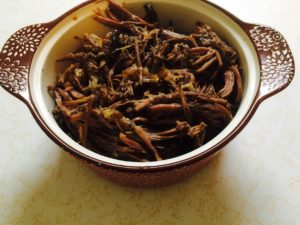
Savory Brisket
As for the tostadas fill that puppy up anyway you like. We topped the shell with refried beans, brisket, onions, lettuce, cheese and fresh tomatoes.
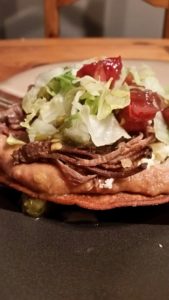
For another application serve it as a pulled apart roast. Remove the fat off the top of the sauce with a turkey baster, remove the garlic & onion, reduce and serve in its own dish. In my house folks a picky about the amount of sauce they use.
We get a lot of questions on what we feed our animals.
GMO? No.
Corn? No, except sweet corn husks from the farmers market.
Grain? Eh, well, actually yes. But not what you think.
In the video above you can see our cows, having just been turned out onto a new paddock, eating the seed heads from fescue grass. They will eat about 80% of the seed heads, mixed in with the grass they normally eat. These grains are only available for a few weeks in the spring and the cows make full use of the opportunity scarfing all they can while they can. Does this mean our cows are grain fed? I can hear you saying now, “I thought cows weren’t supposed to eat grain. It’s bad for the stomachs or something.” Cows eat whatever they can get naturally. If there is grain available, they will get into it and it will put on fat, just like they do in the feed lots. The difference on our farm is that the cows only get grain when it’s in season (spring) and it’s only a small part of their diet, just like if they were roaming wild.
The plus side for us is we can finish grass-fed cows in June, process in July, and have some marbling in our meat and fat on the hide. Despite what the dietitians would have us believe, fat is what it’s all about. That’s how steaks are graded, based on the marbling of fat.
So don’t worry, our cows are still grass-fed and grass finished, and even the grain they get is grass.
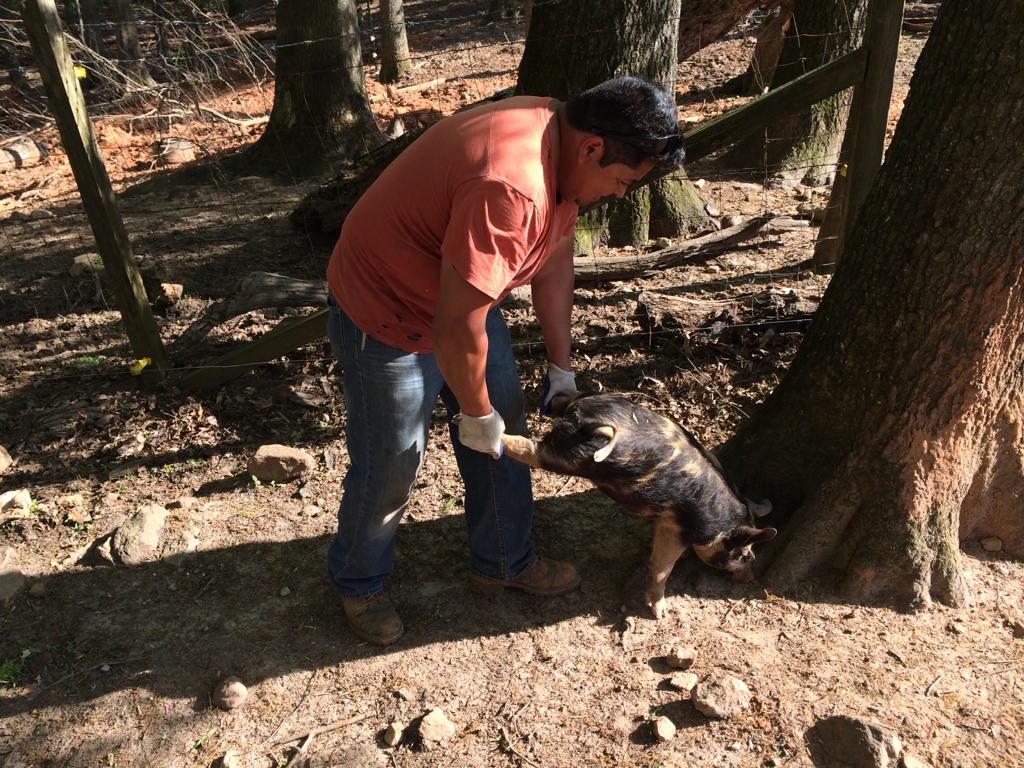
With Penelope having new babies, we had to move the feeder pigs we purchased into the barn. They are too small to be with the two grown boys, and too big to be around Penelope’s babies. We try to have our pigs in similar sized groups but sometimes it just doesn’t work out that way. Catching these little pigs was a bit of an adventure. John, Miguel, and I made a few laps of the pig pen chasing them around and there were a few dives into the dirt catching squirming pigs. It all worked out and Miguel was surprised to see me “wheelbarrowing” one of the pigs after we caught him. He decided to give it a try himself. We only did this a few feet, then because of their small size just picked the pigs up and carried them to the barn.
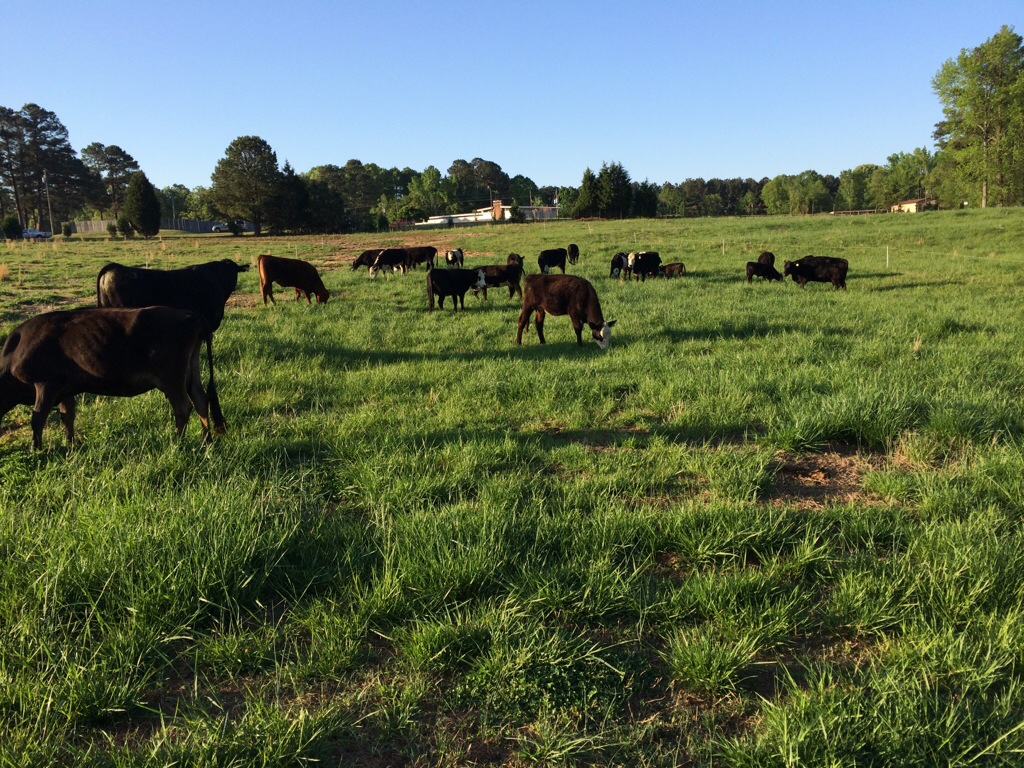
Today the cows were moved into the bottom of the draw in the main pasture. The grass is growing very well and the cows now have more than they can eat in each paddock. They are getting more protein than they need and their stools are loose. I don’t have any hay to supplement them with so we’re just going to have to work our way through this period until the grass gets a little taller and has more fiber to it. The warm season grasses haven’t started coming back yet but the fescue and clover are going gangbusters.
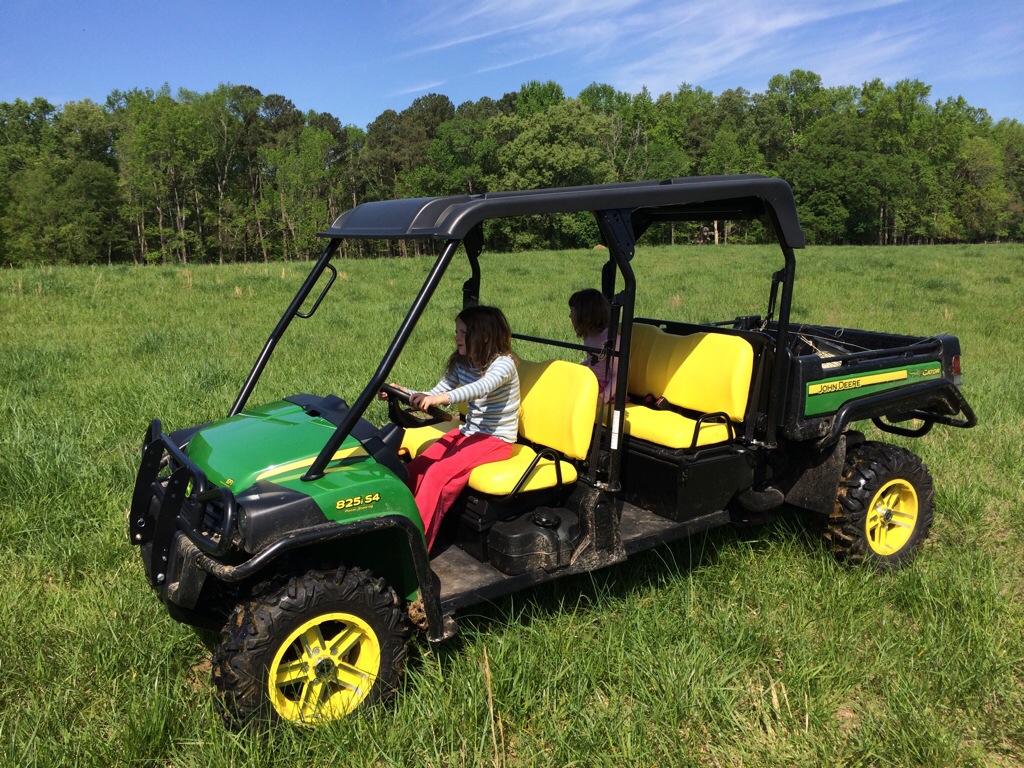
This is the end result of years of work. I’ve wanted one of these gators for a long time and I’ve been working actively on getting one for about a year. I finally have pulled off the deal and on Friday I brought home this monster gator. We set paddocks today for the cattle and the two girls came out to help, as long as they could drive the gator and not actually do any of the work. Kids!
The good news is if you’re coming for a tour, we have more options for you if you cannot walk. Sometimes people like to bring grandma or grandpa or more often they have small kids. If you need to ride rather than walk, just let me know when you contact me about taking a tour.
Another reason I haven’t been in a hurry to sell any cows is because I just haven’t been satisfied with my meat quality.
Firstly, I am my own worst critic. I have people that love our meat and would buy it today if I had some for sale. Despite this I continue to hold back and work on our methods until I am satisfied.
Second, I go to various local meat sellers on occasion and buy their beef. We don’t have our own beef in the freezer so it makes Darling Wifey happy to have a steak occasionally plus its market research for me. What I have found is that while I may not be happy with my beef, I am much happier than I am with some of the beef being sold. I’ve stood in line to buy beef that I ended up giving to my dog. I am not knocking other peoples product but there is such a demand for grass fed beef that people are lined up for beef that I don’t think passes muster. I thought maybe this was a local phenomenon but recently I had the occasion to have a grass fed ribeye steak in a very nice restaurant. The steak cost $66 for a 16oz. The flavor was good however the steak itself was tough to the point I couldn’t cut it with the knife provided and I pulled out my pocket knife, which was very sharp, in order to finish my steak. The restaurant was very proud that their steak came from this California grass fed beef operation which I am sure is very successful and well run. I had a revelation while eating that $66 steak. I can produce steaks this good. If this is a well finished grass fed steak good enough to be exported to another state and sold in a high end restaurant then I am being too hard on myself and my cows.
I am going to continue to try to do better but grass fed is different than grain fed and that’s not only ok, it’s what we want. Real flavor, real meat. We have our first cow that should be ready this spring, with more coming. A large part of that cow will be going in my freezer to feed my family. If it passes the test, we will have more for sale not too long after that. It will be good to be back in the sales business and bringing in some income to the farm. It will also be great to finally be able to say yes when customers want to buy from me. I hate saying no to a customer.
Yesterday when I explained how I had no cows for sale for years you had to ask yourself, “Surely there is a better way to do this. Everybody doesn’t go four years before they produce income, do they?” No, of course not. What someone in my situation would normally do is buy stocker cattle and finish them out in one season. Some farmers, that’s all they do. They buy stockers in the spring and sell them in the fall. Joel Salatin does this and sells a ton of beef all over Virginia.
However, I have an issue with this method of selling on my farm, and my issue is I feel it can be deceiving to the customer. Let’s say you are coming to me to buy grass fed beef. You come out to the farm and I show you our lush pastures, our happy cows, our organic management, etc. You see such a difference in what we do compared to factory farms and you feel justified in paying a premium for our holistically raised beef over supermarket beef. You feel good about your purchase because you are comfortable with what is going in your body and your families bodies and you are also supporting a healthy and sustainable operation. Everybody is happy.
However, what if you found out some months later that my cow I sold to you had only been on my farm less than a year. It wasn’t born there but had come from a cattle auction where I went and purchased cows already 75% grown. I have no idea where these cows came from nor do I know how they were fed, treated, vaccinated, weaned from its mother, etc.
Even though that cow spent nearly a year on my farm, that’s not even half of its life. Did all that could have been done wrong magically disappear the day the cow arrived on my farm? No. Will my management make whatever was done better? Sure, but how much better? There is research that shows cows are different from each other based on how the mother ate while the calf was in the womb. These cows are different all of their lives and even the next generation is different because of what the grandmother cow ate. What happens early in a cows life affects it for life, as it does for our children.
When you buy a cow from me, it was born on my farm and lived the type of life you are seeing and buying all the way through. That’s what I feel I am representing when I sell to a customer and buying and raising stockers breaks that trust you have in me, in my opinion. Joel Salatin knows his breeders and is very public that he buys stockers. I don’t think anything bad about what he is doing and don’t want to infer I do. I just don’t feel comfortable with that type of operation on my farm, with my customers.
Tomorrow the last part of this series.
I said in the last post it was good news long term that we had all female cows but bad news short term. Well short term is relative. It takes about 2 years to grow an American style finished cow. In other countries it takes longer or shorter depending on their palate but here we target the 18-24 month range. With a year of only females, then 2 years to finish, plus the 9.5 months of gestation for the cows to be born, you can see that it takes years to develop a beef program. All the while the expenses mount and people question your sanity for being in this business when you produce no revenue. This is why we grow pigs since they are ready for market in 6 months. Speaking of, we do have pork available if anyone wants some. Just let me know.
Tomorrow part 4.